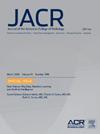Using A Surgical Risk Predictor to Estimate Percutaneous Cryoablation Adverse Event Risk: A Single Center Comparative Analysis
IF 4
3区 医学
Q1 RADIOLOGY, NUCLEAR MEDICINE & MEDICAL IMAGING
引用次数: 0
Abstract
Objective
To evaluate the relevance of established surgical risk calculators for predicting complications in patients undergoing percutaneous lung cryoablation (PLC).
Methods
The institution’s database was queried for PLC procedures from March 2015 to May 2024, excluding those patients with concomitant local therapies or five or more lesions treated in a single setting. Demographics, frailty metrics as defined by the surgical literature, and procedural variables were collected. To evaluate the suitability of surgical risk estimate calculators, the requisite demographic data were input into the American College of Surgery surgical risk calculator; estimates for length of stay (LOS), serious complications, 30-day readmission, and mortality were calculated to determine the comparative risk profile were the patients to have undergone surgical wedge resection instead of PLC. Additionally, to evaluate the suitability of imaging predictors of complications, the volume of emphysematous lung was calculated using a machine learning algorithm and incorporated into a generalized estimating equation logistic regression analysis of other demographic and technical variables.
Results
The study included 217 patients who underwent 314 procedures. Chest tubes were placed in 49% of procedures. The median LOS was 1 day (interquartile range: 1-1, range: 0-13). The median percentage of emphysema within the lungs was 5.9% (interquartile range: 2.4%-12.1%, range: 0.01%-50.3%). The median predicted surgical rates for serious complications (13.5%), 30-day readmission (12%), and 30-day mortality (5.9%) were all greater than actual rates after PLC (1.6%, 4.8%, and 0.3%, respectively). The estimated surgical LOS differed significantly from the actual PLC LOS (5 days versus 1 day, P < .001). In univariable analysis, the number of probes the number of tumors ablated (odds ratio 1.90, 95% confidence interval 1.18-3.05, P = .008) and the number of probes used (odds ratio 1.44, 95% confidence interval 1.06-1.96, P = .021) were significantly associated with increased LOS, but demographic and emphysema details were not.
Conclusion
Complications after PLC are significantly less frequent than the estimated complication risks for wedge resection in the same patient population. Risk estimate calculators tailored to PLC would help screen for high complication risks related to this procedure.
筛选经皮肺冷冻消融不良事件风险:单中心比较分析与手术风险评估。
目的:评价已建立的手术风险计算器(src)预测经皮肺冷冻消融(PLC)患者并发症的相关性。方法:查询该机构数据库2015年3月至2024年5月的PLC程序,排除合并局部治疗或单个治疗的五个或五个以上病变的患者。统计数据、由外科文献定义的衰弱指标和程序变量被收集。为了评估手术风险评估计算器的适用性,将必要的人口统计学数据输入美国外科学院SRC;计算住院时间(LOS)、严重并发症、30天再入院和死亡率的估计值,以确定采用楔形切除术代替PLC的患者的比较风险概况。此外,为了评估并发症的影像学预测指标的适用性,使用机器学习算法计算肺气肿肺的体积,并将其纳入其他人口统计学和技术变量的广义估计方程逻辑回归分析。结果:该研究包括217名患者,接受了314次手术。49%的手术放置了胸管。中位LOS为1天(IQR: 1-1,范围:0-13)。肺内肺气肿的中位百分比为5.9% (IQR: 2.4-12.1%,范围:0.01%-50.3%)。严重并发症的中位预测手术率(13.5%)、30天再入院率(12%)和30天死亡率(5.9%)均高于PLC后的实际发生率(分别为1.6%、4.8%和0.3%)。估计的手术LOS与实际的PLC LOS有显著差异(5天vs 1天)。结论:在相同的患者群体中,PLC术后并发症的发生率明显低于楔形切除术的估计并发症风险。为PLC量身定制的风险评估计算器将有助于筛选与此过程相关的高并发症风险。
本文章由计算机程序翻译,如有差异,请以英文原文为准。
求助全文
约1分钟内获得全文
求助全文
来源期刊

Journal of the American College of Radiology
RADIOLOGY, NUCLEAR MEDICINE & MEDICAL IMAGING-
CiteScore
6.30
自引率
8.90%
发文量
312
审稿时长
34 days
期刊介绍:
The official journal of the American College of Radiology, JACR informs its readers of timely, pertinent, and important topics affecting the practice of diagnostic radiologists, interventional radiologists, medical physicists, and radiation oncologists. In so doing, JACR improves their practices and helps optimize their role in the health care system. By providing a forum for informative, well-written articles on health policy, clinical practice, practice management, data science, and education, JACR engages readers in a dialogue that ultimately benefits patient care.
 求助内容:
求助内容: 应助结果提醒方式:
应助结果提醒方式:


